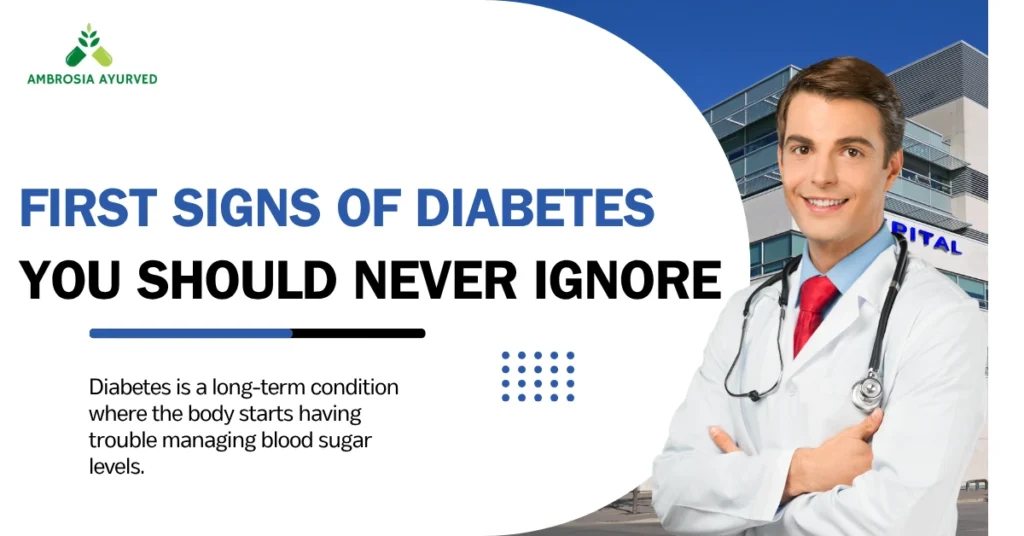Diabetes is a long-term condition where the body starts having trouble managing blood sugar levels. Nowadays, many people across the world are suffering from diabetes, and the numbers are growing every day. It happens when the body either does not produce insulin or is not able to use it properly.
This condition doesn’t appear overnight — it builds up slowly over time, and often we don’t realize it until it’s too late. But some clear early warning signs indicate diabetes is starting, and these are the First Signs of Diabetes that you should never ignore.
There are two types of diabetes: Type 1 and Type 2. In Type 1 diabetes, the body’s immune system attacks insulin-producing cells, so the body cannot make insulin. These symptoms usually appear quickly and can happen to anyone, but they mostly affect children and young people.
In Type 2 diabetes, the body still produces insulin but doesn’t use it properly. This form of diabetes develops slowly, and symptoms are often ignored until it becomes serious. It is most common in adults, but now even young adults and teenagers are being diagnosed with it.
Common Symptoms of Type 1 and Type 2 Diabetes
Most of the symptoms of Type 1 and Type 2 diabetes are quite similar, but some symptoms are a little different. In this section, let’s talk about the common differences — the ones that we must not ignore, because these are the First Signs of Diabetes that give us an early warning.
1. Frequent Urination
Frequent urination is often the first symptom of diabetes. A person suffering from diabetes has to urinate again and again. This happens because excess sugar in the body gets removed through urine. If you feel the need to go to the washroom too many times, especially at night, this may be an early sign of high blood sugar.
2. Increased Thirst
When we urinate frequently, our body loses water again and again. Due to this, thirst increases, and we feel the need to drink water repeatedly. Even after drinking water, the mouth still feels dry. This is because the body is trying to remove extra sugar, and in the process, it causes dehydration. This is one of the First Signs of Diabetes that people usually ignore.
3. Slow-Healing Sores
Another common symptom of diabetes is slow healing of wounds or cuts. Due to diabetes, blood circulation gets weaker, and the immune system doesn’t respond quickly. Because of this, even a small injury or cut takes more time to heal. If you are noticing this regularly, it could be a warning sign of diabetes.
4. Foggy or Blurry Vision
Blurry vision or a sudden change in eyesight is also linked to diabetes. High sugar levels affect the lens inside our eyes and can cause swelling or damage to the blood vessels in the retina. This change causes foggy vision, and it may come and go in the beginning. This is one of the early symptoms of diabetes that shouldn’t be ignored.
5. Extreme Tiredness
People with diabetes often feel tired all the time. Even after proper sleep or rest, the body feels low in energy. Why does this happen? Because the body cannot properly use the glucose present in the blood. Glucose is our body’s main energy source, and when it’s not used properly, we feel weak and tired throughout the day.
6. Unexplained Weight Loss
Losing weight without any reason is also a clear symptom of diabetes. This can happen due to two reasons:
- First, because of increased hunger, we feel like eating something all the time, but still lose weight.
- Second, because the glucose in the body is not being used, the body starts burning fat and muscles for energy. As a result, our weight drops, and our appetite increases.
These are the First Signs of Diabetes that many people notice but don’t take seriously. But by understanding these symptoms early, we can take action at the right time and manage diabetes better before it creates bigger health problems.

Specific Symptoms of Type 1 Diabetes
While some symptoms of diabetes are common in both types, there are a few that are specific to Type 1 diabetes. These are important because they appear more suddenly and can be more intense, especially in children and young people. Let’s look at these signs closely:
1. Irritability and Mood Changes
It is very common to have mood swings and feel irritable in diabetes. This happens because the blood sugar level keeps changing frequently — sometimes it goes too high, and sometimes it drops too low. When the sugar level becomes too high (hyperglycemia), it directly affects our mood. This is why people with Type 1 diabetes often become easily irritated or feel emotionally unstable. These emotional changes are one of the First Signs of Diabetes in children and teens.
2. Fruity-Smelling Breath
If someone suddenly develops a fruity-smelling breath, it can be a strong sign of Type 1 diabetes. This happens because the body is not able to use glucose properly, and instead, it starts burning fat for energy. When fat gets burned, the body releases ketones, and this causes the breath to smell fruity or sweet. This smell is not normal and can indicate a serious imbalance in the body. It’s an early warning not to be ignored.
3. Nausea and Vomiting
Nausea and vomiting are also very common in Type 1 diabetes, especially when blood sugar levels are too high. This again is due to the body burning fat for energy instead of glucose. As fat is broken down, ketones are released into the blood. A high level of ketones makes the blood acidic, which leads to vomiting and discomfort in the stomach. If not treated in time, this condition can lead to diabetic ketoacidosis (DKA), which is serious and needs medical attention.
Specific Symptoms of Type 2 Diabetes
In Type 2 diabetes, symptoms appear slowly and are often ignored in the beginning. But some signs are more specific to this type. If you see these symptoms regularly, it could be one of the First Signs of Diabetes — and you should not ignore them.
1. Frequent Infections
Getting frequent infections is a very common symptom of diabetes. This happens because high blood sugar levels weaken our immune system, making it harder for the body to fight germs. When the immune system becomes weak, bacteria and fungi start growing easily in the body. That’s why people with diabetes often suffer from repeated infections like urinary tract infections (UTIs), skin infections, and yeast infections. If you notice these infections happening again and again, it could be a sign of Type 2 diabetes.
2. Skin Conditions
Skin problems are also a specific symptom of Type 2 diabetes. People often face dry and itchy skin, which is mainly due to dehydration and a weak immune system. High sugar levels in the body create an environment where fungi and bacteria grow, which further worsens skin health. If your skin remains dry, irritated, or flaky for a long time, it might be one of the early signs of diabetes.
3. Darkened Skin Patches (Acanthosis Nigricans)
Dark, thick, and velvety patches of skin — especially in body folds like the neck, armpits, and groin — are another common symptom of Type 2 diabetes. This condition is known as acanthosis nigricans. It happens because the body is not able to use insulin properly. As a result, the insulin present starts affecting the healthy skin cells, leading to the skin becoming darker and thicker in certain areas. If you are noticing such changes in your skin, it could be an important warning sign that your body is having insulin resistance.
Difference Between Symptoms of Type 1 and Type 2 Diabetes
| Symptoms | Type 1 Diabetes | Type 2 Diabetes |
|---|---|---|
| Onset (Start) | Sudden (within weeks) | Slow and gradual (can take years) |
| Age at Onset | Mostly in children, teens, or young adults | Mostly in adults, now also seen in teens/kids |
| Weight Loss | Rapid and unexplained | Happens slowly or may not occur |
| Frequent Urination | Yes | Yes |
| Excessive Thirst | Yes | Yes |
| Increased Hunger | Yes | Yes |
| Fatigue (Tiredness) | Severe and sudden | Gradual and persistent |
| Blurred Vision | Common | Common |
| Nausea / Vomiting | Common in later stages (due to high sugar or DKA) | Less common |
Also Read: Why Do Diabetes Patients Feel Tired All The Time?
Preservation of Diabetes
To live a healthy lifestyle and stay safe from diabetes, we need to adopt good daily habits. These habits not only help us stay fit but also help in preventing the First Signs of Diabetes from turning into something serious.
Preservation Tips:
- Eat Healthy: Include more fruits, vegetables, whole grains, and foods with low sugar in your diet. Avoid processed and high-sugar items as much as possible.
- Stay Active: Do at least 30 minutes of daily exercise, such as walking, cycling, or dancing. Physical activity helps control blood sugar and supports overall health.
- Maintain a Healthy Weight: Keeping your weight in a healthy range is one of the best ways to prevent or delay diabetes.
- Avoid Sugary Drinks and Junk Food: Sugary sodas, desserts, and junk food raise blood sugar quickly. Replace them with healthier options.
- Don’t smoke: Smoking can increase the risk of diabetes and damage blood vessels.
- Limit Alcohol Consumption: Too much alcohol affects blood sugar control and liver health. Always drink in moderation.
- Get Regular Health Checkups: Early testing helps in spotting the First Signs of Diabetes before they turn serious. Check your sugar levels from time to time.
- Manage Stress and Sleep Well: Stress and lack of sleep both increase blood sugar. Try meditation, relaxing activities, and maintain a regular sleep routine.
Final words
The First Signs of Diabetes include increased thirst, frequent urination, unexplained weight loss, fatigue, and blurred vision. When these symptoms start appearing in our body, we should never ignore them. These are not just small health issues — they are the early warnings that diabetes may be starting.
If we ignore them now, they can lead to serious health problems in the future. But by recognizing the signs early, we can take the right steps to control our blood sugar, improve our lifestyle, and take better care of our overall health. Early action can protect us from major complications and help us live a healthier, longer life.




